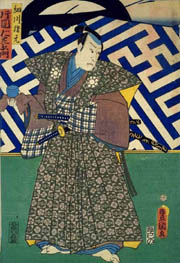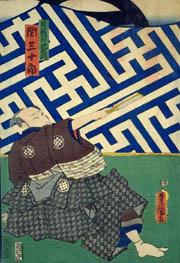| TAIKETSU - NINJď |
| Play title | Meiboku Sendai Hagi Date Kurabe Okuni Kabuki |
| Authors | Nagawa Kamesuke I Isojii Sosuke Sakurada Jisuke I |
| History |
"Meiboku Sendai Hagi" has a complicated history: it was staged for the first time in the 4th lunar month of 1777 as a 5-act drama written by Nagawa Kamesuke I and Isojii Sosuke, which was produced in ďsaka at the Naka no Shibai [casting]. This drama was inspired by "Keisei Mutsu no Tamagawa", the first play dealing with the Date succession troubles, which was staged in the 1st lunar month of 1767 at the Naka no Shibai. Sakurada Jisuke I wrote a similar drama, which was entitled "Date Kurabe Okuni Kabuki" and staged for the first time in the 7th lunar month of 1778 at the Nakamuraza [casting]. Then, the playwrights Matsu Kanshi, Takahashi Buhei and Yoshida Kadomaru wrote a play in 9 acts for the puppet theater, using the title "Meiboku Sendai Hagi" and mixing elements from both the original "Meiboku Sendai Hagi" and "Date Kurabe Okuni Kabuki". This puppet drama was staged for the first time in the 1st lunar month of 1785 in Edo at the Yűkiza. It was afterwards adapted for Kabuki and evolved during the nineteenth century. "The play is based on a real event involving the Date clan of Sendai during the 1660's, but censorship prevented contemporary incidents being dramatized, so the drama was set during the Muromachi period (1336-1568), and names were changed to disguise the protagonists' identity." (text courtesy of Jean Wilson 1998) The 17th Date clan was replaced by the 15th Ashikaga clan and Lord Date Tsunamune, the cause of the succession troubles, became Ashikaga Yorikane in the Kabuki drama. |
| Structure |
The current version of "Meiboku Sendai Hagi" is made up of 3 acts and 6 scenes. The third act is made up of the "Taiketsu" (the Trial) and "Ninj˘" (the Stabbing) scenes. |
| Key words |
Giri/Ninj˘ Hosokawa Katsumoto Jidaimono Sabakiyaku S˘d˘ |
| Summary |
Taiketsu Watanabe Gekizaemon, commonly called Geki, a faithful retainer of Tsuruchiyo, has obtained the proof of the conspiracy against his Lord, led by Tsuruchiyo's uncle ďe Onitsura and the evil Nikki Danj˘. Geki has come to petition against the two evil men at the Court of Justice. The first judge, Yamana S˘zen, is on Danj˘'s payroll and considers Geki to be a country simpleton. Geki's case is doomed from the start. The second judge is not here at the beginning of the trial. When Yamana S˘zen haughtily questions Geki, Geki produces three documents, which are the evidences of Onitsura and Danj˘ plans to get rid of Tsuruchiyo. The first letter was written by Danj˘ and sent to Onitsura, requesting the uncle to assassinate his nephew. Danj˘ denies that he is the author of this letter. the second letter was written by Danj˘ to Geki. The contents of the letter has no importance for the case but Geki uses it to identify Danj˘'s handwriting. The villain admits without trouble that it is indeed his own handwriting. After this acknowledgement, Geki takes a step forward by exhibiting his third letter, a letter from Danj˘ ordering poison to kill Tsuruchiyo. Danj˘ claims that Geki's letter is a forgery and Yamana S˘zen agrees with the villain, without even trying to compare the second and the third letter. Minbu, the son of Geki, makes his appearance on stage. He has brought with him another letter, which is unfortunately in very bad condition. Yamana S˘zen declares that it is not worth looking into and that the case is won by both Onitsura and Danj˘. Then the bad judge burns the most dangerous piece of evidence, the poison order letter. Hosokawa Katsumoto, the second judge, a high-ranking and loyal retainer of the Ashikaga clan, makes his appearance. He is a man of great integrity, and he has heard something about Yorikane's trouble with the conspirators. He starts to question Yamana S˘zen about the case but the accomplice of Danj˘ is reluctant to answer. Geki, who tries to explain what happened, is silenced by Katsumoto, who prefers to focus his attention to Danj˘. After a brief compliment on his victory, he asks Danj˘ whether or not he was aware of Yorikane's debauched life. The answer is negative and Katsumoto takes advantage of it to blame Danj˘ and make him admit that he failed in his role of retainer. He should commit ritual suicide because of this failure. The clever judge, who is enjoying outwitting Danj˘, changes the subject and tells Danj˘ that he would be a better guardian for Tsuruchiyo than Onitsura. He asks him to request the official appointment with a sealed letter. Danj˘ writes the document but, as he is suspecting a trick, stealthily puts a hair under the seal in order to make it look different. Katsumoto asks to take a look at the letter brought by Minbu. This letter is in fact a request for the help of an unknown man to put a curse on Tsuruchiyo. Half of the letter is missing. Katsumoto triumphantly exhibits the missing part, which he has received on his way to the Court of Justice. It is clearly written by Danj˘ to a Mountain Magician. Danj˘ objects to Katsumoto that the seals on the two documents are not identical but his ruse is too obvious and the clever judge reprimands the villain for this failed attempt. Danj˘ makes a new approach to Katsumoto by asking him to send both him and Geki to the torture chamber in order to let the torturers get the truth out of their mouths. Katsumoto is shocked by this idea, which is unworthy of a samurai. Danj˘ is younger and stronger than the old Geki, who would most likely died quickly under torture. Because of the strength of the evidences against Danj˘, Katsumoto quashes Yamana S˘zen's judgement and declares that Onitsura and Danj˘ are guilty. They are very angry but have to retire from the Court of Justice. Ninj˘ The hearing being over, Geki is congratulated by his son and his supporters. The old man is finally left alone and he can thank to the Gods for his unhoped-for victory. Danj˘ enters the room and begs Geki to be allowed to die an honorable death, by seppuku as it is the way for samurai. At first Geki shows no inclination to grant Danj˘'s request, but finally consents when the villain offers to provide him with the list of all the conspirators involved in the plot against Tsuruchiyo. There is a dagger hidden in the scroll but Geki is taken by surprise and stabbed by Danj˘. Geki defends himself bravely, but at the sound of the commotion, everybody rushes at Danj˘. The villain can't move anymore and the deathblow is given by the wounded Geki. Katsumoto arrives on stage and congratulates Geki for the killing of Danj˘. He knows that the old man won't survive and gives him some medicine to ease the pain. He praises Geki's efforts for the Ashikaga clan and, when the old man asks to be allowed to go home, offers him to travel in his own palanquin. Geki will soon die comforted by the knowledge of the victory of his Lord over the conspirators and Katsumoto announces that a celebratory dance will be presented in honor of the occasion. |
 |
 |
 |
|
The actors Kataoka Nizaemon VIII, Seki Sanjűr˘ III, Band˘ Hikosabur˘ V and Kataoka Gat˘ II playing the roles of Hosokawa Katsumoto, Izutsu Gekizaemon, Nikki Danj˘ and Yamanaka Shikanosuke in the drama "Date Kurabe Okuni Kabuki", which was staged in the 4th lunar month of 1861 at the Nakamuraza (print made by Utagawa Toyokuni III) |
||
|
|
| Contact | Main | Top | Updates | Actors | Plays | Playwrights | Programs | Links | FAQ | Glossary | Chronology | Illustrations | Prints | Characters | Derivatives | Theaters | Coming soon | News |